Project 1135 Burevestnik (Bditelnyy class) ASW Frigates
 33 ASW Frigates, NATO Krivak I, II, III and IV, 1975-1990
33 ASW Frigates, NATO Krivak I, II, III and IV, 1975-1990
Bditelnyy, Bodryy, Svirepyy, Silnyy, Storozhevoy, Razumnyy, Raziashchiy, Druzhnyy, Dostoynyy, Doblestnyy, Deyatelnyy, Bezzavetnyy, Dnipropetrovsk, Bezukoriznennyy, Ladnyy, Poryvistyy, Zharkiy, Retivyy, Letuchiy, Pylkiy, Zadornyy, Pytlivyy, Rezvyy, Liogkiy, Rezkiy, Razitelnyy, Sevastopol, Groziashchiy, Neukrotimyy, Gromkiy, Bessmennyy, Gordelivyy, R’yanyy, Revnostnyy, Pytlivyy
The Krivak class were born under the Soviet designation Project 1135 Burevestnik (“storm petrel”) as replacement for the Riga class, the last of the cold war. These Frigates and guard ships appeared from the mid-1970 and 40 were built in several batches and evolutions. Sub-branches, like the Nerey class were designed for coastal patrol and used by the KGB Border guards. Until 1977, they were considered as traditional anti-submarine warfare vessels but this changd as armament was diversified. For NATO they were known as the Krivak, divided into four sub classes classes.
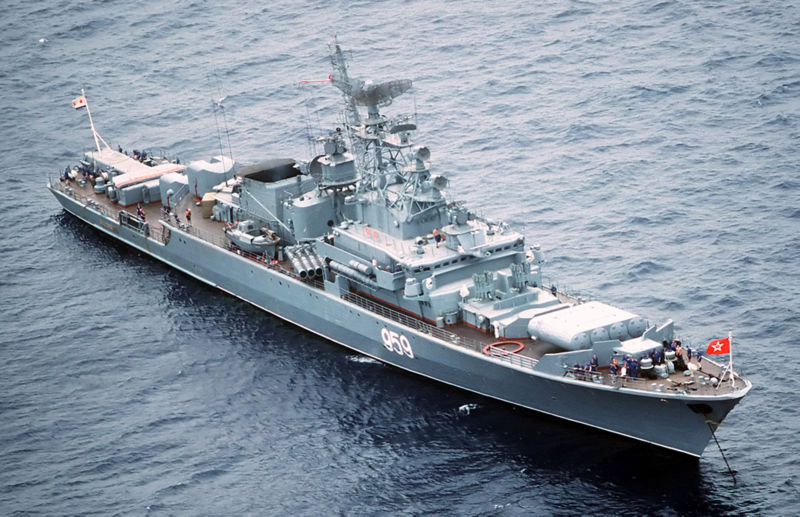
Development
Designed as Kresta class cruisers in reduction
The Krivak class frigates were designed as successors to the 1950s Riga class and thus, the very early designs emerged in the late 1950s already, matured as larger missile-armed anti-submarine ships in the sixties. In the end, some 42 ships were planned to be built before the collapse of the Soviet Union.
Project 1135 was developed in 1964-1966 at the Northern Design Bureau. The naval staff wanted a large anti-submarine ship, second class and ocean-going, based on projects 1134-A and 1134-B (Kresta class cruisers), but with a significantly reduced displacement. This program was supposed to take on a wide range of tasks, mosty around ASW defence air defense of ship formations, or escorting convoys through combat areas.
The reduction in displacement led to the deletion of an helicopter while the hydroacoustic of the 1134-B project was retaken. However the radar suite was too light to guide the main antiship missiles at full range, so ships were supposed to operate in search-and-strike pairs.
Initially, the main armament was to be the “Metel” missile-torpedo system, but during modernizations it was replaced by the more capable Rastrub-B, and doubled against surface targets.
Construction
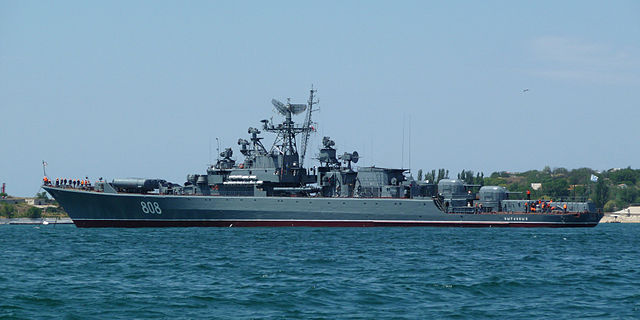
Project 1135M Pytlivyy in 2009
Construction was carried out at three shipyards: A. A. Zhdanov in Leningrad, “Yantar” at Kaliningrad and “Zaliv” in Kerch. The serie was so long it was declined into three main variants:
Project 1135 21 ships built 1968-1981, NATO Krivak I
Project 1135M 11 ships 1973-1981, NATO Krivak II
Project 1135.1 7 ships 1973-1981 (NATO Krivak III) 7 built 1981-1990 differing in displacement and armament for the Border Guards.
Project 1135.2 Modified versions of the same, four Krivak I ships modified as Krivak IV.
Project 1135.5 Nerei 10 ships 1973-1981 (NATO Krivak III) for the Navy.

Yantar Yard Model of the Krivak I, detail
A total of 32 ships were built, 48 in absolute total including 40 for the Soviet Navy alone. 21 Krivak I until 1981 and another one was planned, but was not laid down. From 1975, in parallel were developed a modernization, Project 1135M were built with 11 built and the class was rounded by the border patrol ship “Nerei”, including three not given to the border guards, one was assigned to the Navy and two others to Ukraine.
In 1999-2013, under Project 1135.6, six ships were built as Talwar-class frigates, delivered for the Indian Navy.
From 2010, a program was setup to build six Project 1135.6R frigates for the Russian Navy. Main differences between with the export variant are the new weapons and updated hull using stealth technology.
Eventually after Bditelnyy commissioned in 1970, 40 ships were commissioned, including those of the Navt (Krivak I, II, IV) and eight Krivak III for the KGB Maritime Border Guard.
Their unique feature which distinguished themselves from all past designs was their their large bow missile box, stack and angled mast. US sailors seeing their well known silhouette since they used to be shadowed by them in the late 70s and 1980s used to sing “Hot dog pack, Smokestack, Knife in the Back, two Guns in the Back — Krivak.”
Post Cold War constructions:
The Indian Navy ordered six upgraded Krivak III ships, they became known as the Talwar class delivered in two batches, in 2003–2004 and 2011–2012. On 12 October 2010, also Yantar Shipyard, Kaliningrad announced being contracted for construction three new warships of the same type as India frigates and built in parrallel as those for the Indian Navy.

An aerial starboard bow view of the Soviet Krivak I Class guided missile frigate 959 at anchor.
Design of the class
Hull and general design

All these ships, whatever the version, shared the same hull, and powerplant. In Standard they displaced 3,300 tons, and fully loaded, 3,575 tons. Compared to a Kresta II hull it was of course way shorter, more compact, but still relatively wide, with an overll lenght of 405.3 ft (123.5 m), a beam of 46.3 ft (14.1 m) and a draught of 15.1 ft (4.6 m). The hull was beamy all the way to the rounded transom stern. The prow was edgy and ended underwater with the sonar bulge. There were counterkeels and stepped sides, as well as a lower stern deck (or 4/5 long forecastle) ensuring some livability. However these ships had the reputation of being cramped. The Krivak I had 200 men for crew. This went down with more recent derivatives. This was indeed improved on recent Russian sub-projects, thanks largely to automation.
By dimensions and tonnage they had nothing to do with the small previous ASW frigates and more, for example, with semi-contemporary like the East German Parchim or simply the USN OH Perry, which were larger and bulkier.
The profile is balanced, with a low armament, guns at the rear, central bridge and structure supporting the lattice mainmast, small aft mast and blocky funnel. These ships had a low profile and they armed “to the brim”, notably when looking at their massive quad missile launcher formward, reminiscent of the old Kynda class missile cruisers.
Powerplant
These Frigates were not the first with Gas Turbines (The Petya class inaugurated this), but they had a much more powerful system: On two shafts they combined two M-8k, 40,000 shp (30,000 kW) or DK59 13.5 MW or DT59 16.9 MW gas-turbines and two M-62 7.4 MW or DS71 13.4 gas-turbines (for cruising) rated for 14,950 shp (11,150 kW total.)
Top speed was 32 knots (59 km/h) and range 4,995 nmi (9,251 km) at 14 knots (26 km/h).
Armament
ASW Missiles
Quad URK-5 (SS-N-14 ‘Silex’) SSM/ASW missiles: The Metel Anti-Ship Complex (“Snowstorm”) were anti-submarine missiles designed in the 1960s for the Kresta class cruisers, entering sevrice in 1969 and here in the Frigate variant, with later Krivak class given the the shaped charge (‘Rastrub’) usable now against shipping as well as submarines.
Like the ASROC, the missile carries an underslung anti-submarine torpedo drops above the suspected position, launched homing search. The 85RU/URPK-5 carries the UGMT-1 torpedo, multi-purpose for subs and surface ships. In later versions of the Krivaks, it was supposed to be replaced by the RPK-2 Viyuga (SS-N-15 ‘Starfish’) but the upgrade program was cancelled in 1991.
⚙ specifications URK-5 (SS-N-14 ‘Silex’) |
|
| Weight | 3,930 kg (8,660 lb) |
| Dimensions | 7.2 m (24 ft) (85R missile) |
| Propulsion | solid fuel rocket |
| Speed | Mach 0.95, 290 m/s (650 mph) |
| Range | 50 km anti-sub, 90 km URPK-5 Rastrub anti-ship, torp. 500 m |
| Guidance | Missile: Radar, datalink, Torpedo: Homing pattern. |
| Payload | ASW torpedoes/nuclear depth charge/185 kg shaped charge |
SAM
Two Osa-MA SAM vertical systems SA-N-4 ‘Gecko’ SAM (40 missiles). A “classic” on all soviet surface ships, this is a short range missile system here ina twin arm launcher, reloading vertically.
The 4K33 “OSA-M” was introduced in 1972 as the naval version of the system. Each is composed of a two armed Zif-122 retractable launcher with 9M33M missiles. Present on the Gepard-class frigate, Kara-class guided missile cruisers, Kiev-class VTOL cruisers and also the Kirov, Slava and Krivak classes.
⚙ specifications Osa-MA (SA-N-4 ‘Gecko’) |
|
| Weight | 170 kg |
| Dimensions | 3,158 x 209.6 mm |
| Propulsion | Solid propellant rocket motor, 2 s boost, 15 s sustain |
| Speed | 1020 m/s |
| Range | 15 kilometres (9.3 mi), ceiling 12,000 metres (39,000 ft) |
| Guidance | RF CLOS dual-thrust rocket motor, Accuracy 5 m |
| Payload | Frag-HE 16 kg, Contact and proximity fuse |
Cannons
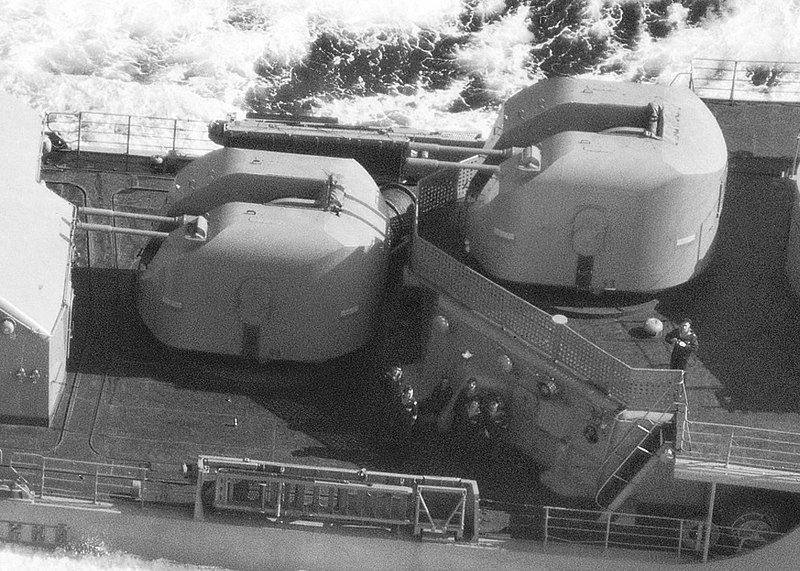
Two twin 76 mm AK-726 guns aft. The Burevestnik-M had 2 single 100 mm AK-100 guns.
The AK-726 were twin mount turrets, aft and superfiring, one on the dying end of the forecastle, the other on the aft weather deck. These were still old generation weapons system in the line of 1950s turrets, crew-intensive (nine). They were slaved to radars. Studies started in 1954 for a light, very fast dual purpose gun, developed at TsKB-7 (later Arsenal Design Bureau) under Pyotr Tyurin. Tests started in 1958, pre-service tests started in 1962, full service by June 24, 1964. They were exported also but judged too light and replaced by the AK-100.
⚙ specifications AK-726 |
|
| Weight | Mount: 26t, 76.2mm (3 in)/59 cal. Round: |
| Elevation | −10° to +85° |
| Loading system | Sliding wedge Breech |
| Muzzle velocity | 980 m/s (3,200 ft/s) |
| Range | 15,700 m (17,200 yd), ceiling 11,000 m (36,000 ft) |
| Guidance | Fire Control Radar |
| Crew | 9 |
| Round | 5.9 kg (13 lb), Frag, HE, Proximity fuse self-destruction |
| Rate of Fire | 2 × 40–45 RPM |
The AK-100 weights 35.5 tonnes (78,000 lb) with a shell weight of 26.8 kg (100mm caliber), HE anti-air or HE fragmentation, and is able to elevate to +85 degrees. Rate of fire is 60 rounds per minute.
ASWRL
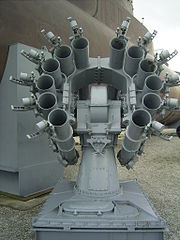
Two RBU-6000 anti-submarine rocket Launchers, a pair located just aft of the OSA-M launcher.
⚙ specifications RBU-6000 (1960)/RPK-8 (1990) |
||
| Launcher: | 3100-3500+4700t, 2 x 2.25 x 1.75 elev.+65° Tr.180° | |
| Specs | RGB-60 Rocket: | 90R Rocket: |
| Weight | 112.5 kgs | 113.5 kgs |
| Sink Rate | 11.6 m/s | 11.6 m/s |
| Range | 350/1500 m to 1700/5500 m | 600 m to 4,300 m |
| Seek radius | N/A (not homing) | 130 m |
| Target Depth | 10 to 500 m | Submarines 1,000 m, Torpedoes and divers 4–10 m |
| Warhead | 23 kg, explosive | 19.5 kg, shaped |
TT: 2×4 TEST-3
Two quadruple 533 mm torpedo tubes banks on either beam, aft of the main bridge. They are known to be related to the TEST-3 type, developed from the TEST-71 and TEST-71MKE used on submarines.
The TEST-3 was a specific version designed for the Krivak class, entering service in 1977. It’s possible the first ships in the interim they used the SET-65 “Yenot-2”.
These ASW wire-guided torpedo with active/passive acoustic homing.
⚙ specifications TEST-3 |
|
| Weight | Unknown, close to 4,000 lbs. (1,800 kg) |
| Dimensions | 311 in (7.900 m) |
| Propulsion | Silver-zinc battery |
| Speed | 35/40 knots |
| Range | 27,300 yards (25,000 m)/6,400 yards (15,000 m) |
| Underwater range | Homing 880 yards (800 m), 1,300 feet (400 m) depth. |
| Payload | 452 lbs. (205 kg) |
Sensor suite
Main Radar: MR-755 Fregat-M/Half Plate air/surf search (lattice mainmast)
Sonar: Zvezda-2 suite with MGK-345 Bronza (NATO Ox Yoke) bow mounted LF and (NATO Ox Tail) LF VDS (Vertical Dipping Sonar)
Fire control: Purga ASW combat system, two two Drakon (NATO Eye Bowl) SSM targeting radars and two MPZ-301 Baza (NATO Pop Group) FCR
Electronic warfare: NATO “Bell Shroud” intercept system, NATO “Bell Squat” jammer, and four PK-16 decoy Rocket Launchers, eight PK-10 decoy Rocket Launchers and two towed decoys
Variants
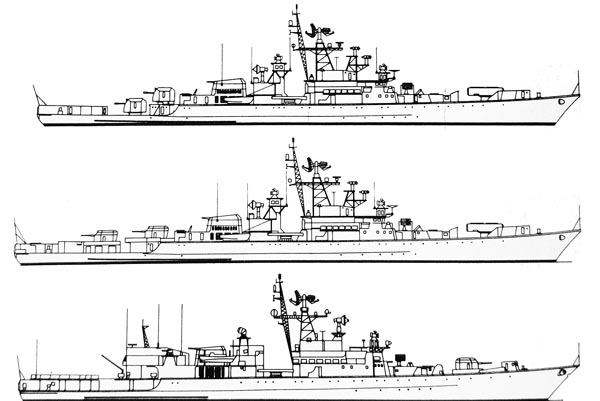
Project 1135 Burevestnik (Krivak I) 1975:
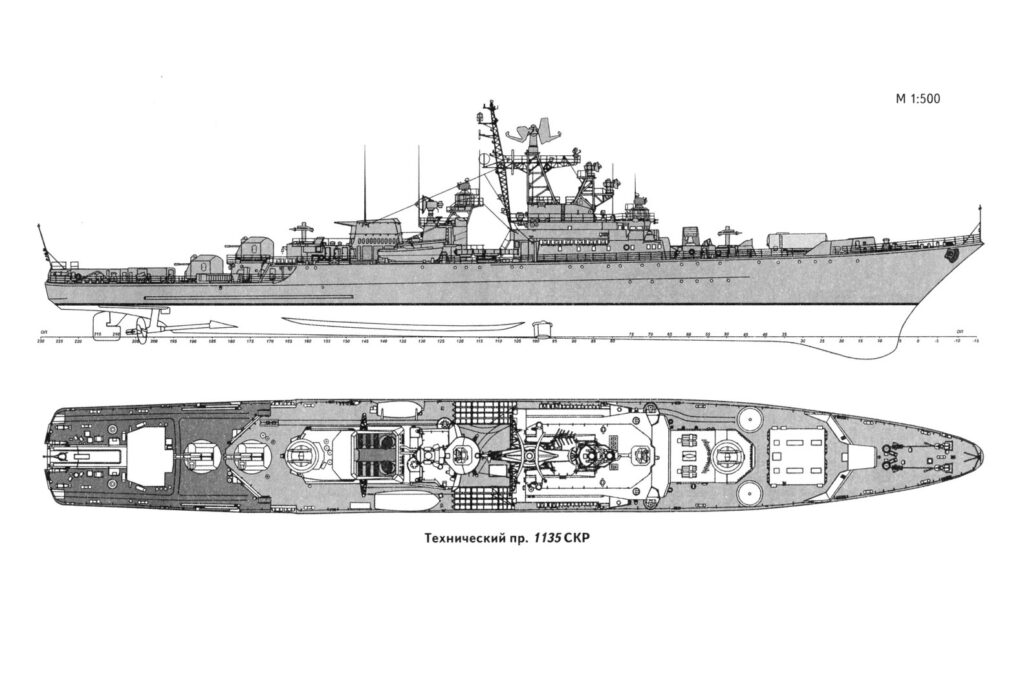
Design process started in 1956, role changed to ASW ships powered by gas turbines, with four SS-N-14 missile. Built at Zhdanov Yard (now Northern Shipyard), Leningrad, Yantar, Kaliningrad, Kamysh Burun Yard, in Kerch, Crimea with 21 ships built until 1981.

Bditelny before and after modernization 1971-1990
Project 1135M Burevestnik M (Krivak II) 1980:
They were fitted with single 100 mm AK-100 guns instead of two twin 76 mm AK-726, and fitted with a Variable Depth Sonar (VDS). All eleven built in Kaliningrad.
Project 11351 Nerey (Krivak III) 1990:
These ships lacked the SS-N-14 missile system replaced by a helicopter and its hangar, one 100 mm gun at the bow. All were built in Kerch for Soviet Border Guards (KGB). Two are now kept with the Russian FSB Coast Guard, and since 1990, one joined the Ukrainian Navy until scuttled in 2022 to avoid capture. An incomplete Krivak III, Ukrainian Hetman Bayda Vyshnevetsky by 1995 was retransferred to Russia and resold to the Korean People’s Navy. 8 ships were built.
Project 11352/11353 (Krivak IV) 2000:
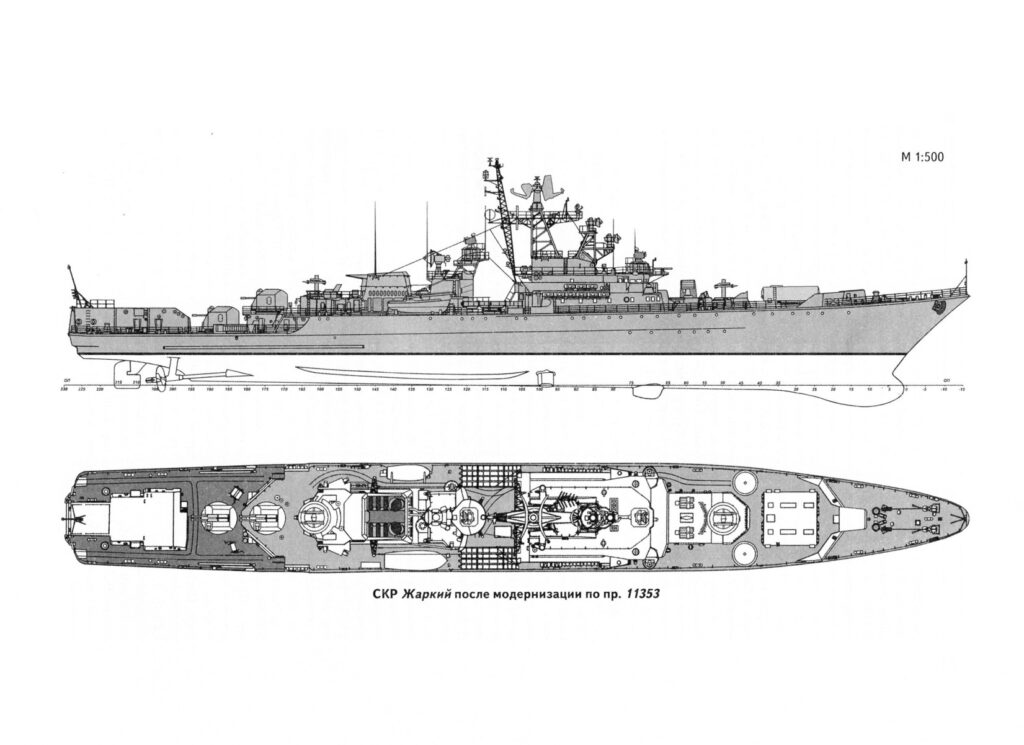
Project 11353
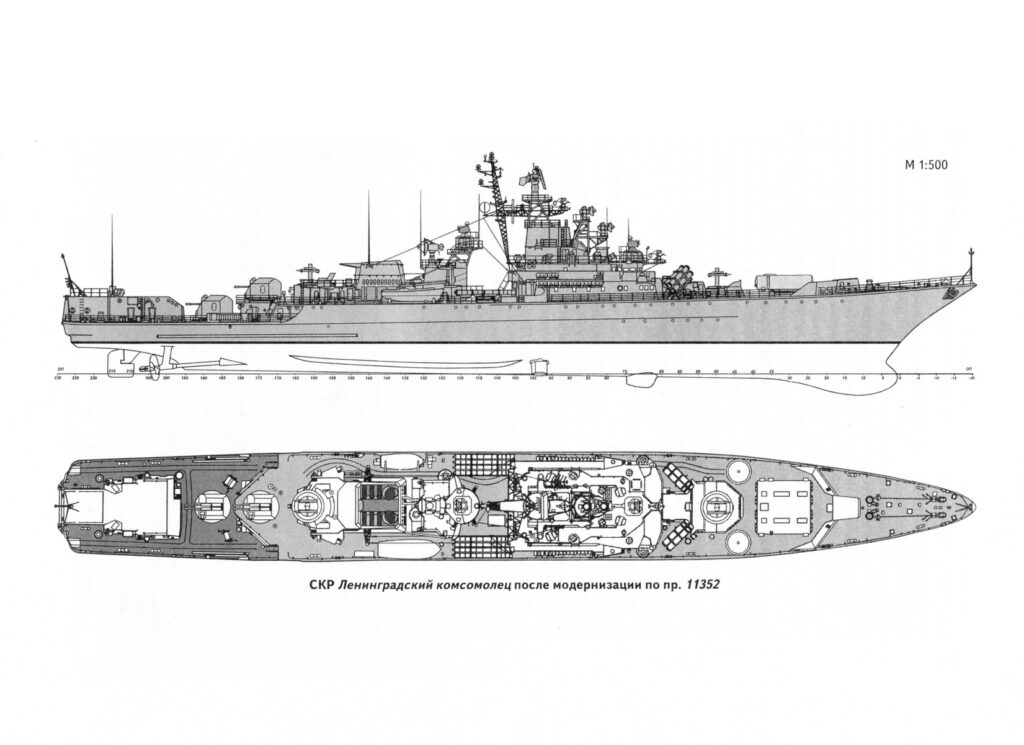
Project 11352
This was a modernization of the the Krivak I: These were the Leningradski Komsomolets (renamed Legkiy in 1992), Letuchiy, Pylkiy and Zharkiy of the Krivak I group.
-RBU-6000 by SS-N-25 anti-ship missiles
-New radar, sonar, EW equipment.
Refits completed in 1990–1992, programme not extended to others, but cancelled with the collapse of the Soviet Union.
Project 11356 (Talwar class):
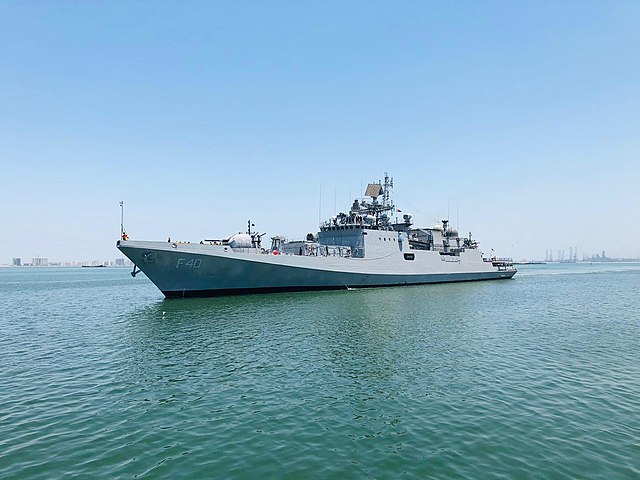
Advanced derivative built for the Indian Navy from 1999 to 2012. Three improved “Nerey” frigates were also ordered by the Indian Navy on 17 November 1997, also assimilated to the Talwar-class frigates. Three more were fitted in India with the new BrahMos missile. They were ordered by July 2006.
Project 11356R/M (Admiral Grigorovich class) 2011:
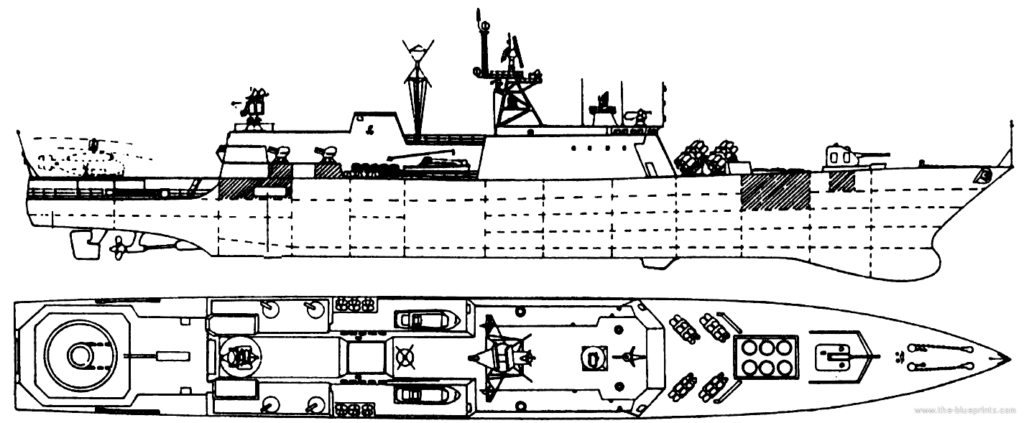
Derivative of the Talwar class intended for the Russian Navy. Six ordered for the Russian Black Sea Fleet under two contracts, signed in 2010–2011. First laid down on 18 December 2010. As the Ukrainian built gas-turbines were not delivered after the start of the war in Donbass by 2014, construction of Admiral Butakov and Admiral Istomin was suspended in the spring 2015. By October 2018, it was announced that Butakov and Istomin were to sold to India for $950 million, and completed there. The last frigate Admiral Kornilov is still to find a customer. sold abroad. Only three ships were built for the Russian Navy so far.
Modernizations
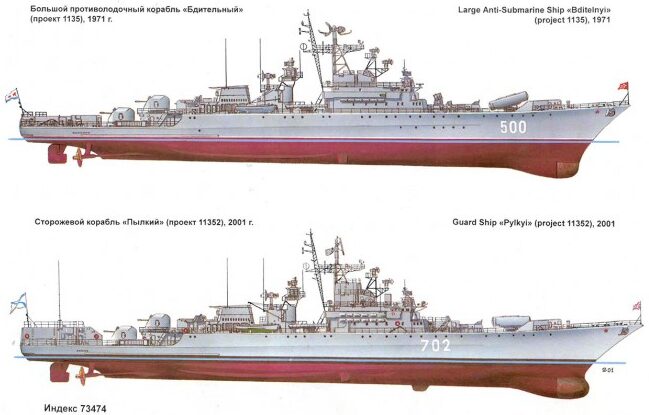

Old author’s illustration
⚙ specifications Krivak I |
|
| Displacement | Standard 3,300 tons, Full load 3,575 tons |
| Dimensions | 123.5 x 14.1 x 4.6 m (405.3 x 46.3 x 15.1 ft) |
| Propulsion | 2 shaft COGAG M-8k 40,000 shp (30,000 kW), see notes |
| Speed | 32 knots (59 km/h) |
| Range | 4,995 nmi (9,251 km) at 14 knots (26 km/h) |
| Armament | Quad URK-5 SSM, 2× Osa-MA SAM, 2×2 76 mm AK-726, 2× RBU-6000, 2×4 533 mm TTs |
| Sensors | MR-755 Fregat-M/Half Plate, Sonar Zvezda-2, Purga ASWCS, 2 Drakon/Eye Bowl, 2 MPZ-301 Baza/Pop Group |
| Crew | 200 |
Operational life and status in 2023
Currently 2 vessels of the Nerey subclass are in service with the FSB Coast Guard and one was the flagship of the Ukrainian Navy (scuttled in 2022 to avoid capture).
Read More/Src

Books
Conway’s all the world’s fighting ships 1947-95, soviet navy section
MKL-200106 Naval Collection 06/2001: Bditelny-Class Soviet Frigates 1135 Project, Morskaya Kollektsia
Links
ww2.dk/
russianships.info/
1982 Bundesmarine, translated, declassified analysis, Krivak II class, USN
admiral_grigorovich_class mil.today
warsearcher.com russian-navy-current-and-retired-surface-units/russian-frigates/
on globalsecurity.org, list
globalsecurity.org main portal, krivak
on naval-technology.com/
krivak articles on navyrecognition.com
on navalnews.com project 11356-frigate tushil completion
militarytoday.com talwar_class.htm
navalanalyses.com infographics-of-coast-guard-vessels-3.html
major soviet warships cold war – jstor.org/
on navypedia.org/
hazegray.org/
navweaps.com/
on en.wikipedia.org/
ru.wikipedia.org project 1135
commons.wikimedia.org/ Krivak_class_frigate
en.wikipedia.org bumping incident
Videos
Model Kits
General query on scalemates
Pit-Road, Youfeng Model, YG Model 1:700, and Argos by Jeorg Uter 1:1250. Not many models to go around.
3D
Career of the Krivak class ships
With 40 ships operational, there’s a lot to cover so i will go essential facts as reported from Russian sources. Full records, translated on ww2.dk
In 1975, a riot took place at the Storozhevoy, calling for a new communist revolution. This mutiny/defection inspired Tom Clancy for his “hunt for the red october” novel.
In 1988, one of these frigates, Bezzavetny, “bumped” aggressively the Ticonderoga class cruiser USS Yorktown, ousted from alleged territorial waters in the black sea. White house protests were about the differences between the Soviet limit and internationally recoignised limits.
As of 2012, several ships Pr.1135 and 1135M remained in the Russian Navy. A further evolution of the Project 1135 patrol ships, the Talvar-class were ordered to the Baltic Shipyard OJSC and PSZ Yantar OJSC. In 2013, the program to build three ships Project 1135.7 (improved Talwar) for the Black Sea Fleet commenced, as long as two additional for the Baltic Fleet but Project 11357 was later unified with the Project 22350 frigates in equipment and senors, to reduce differences to a minimum and simplify maintenance. Ten Admiral Gorshkov class are planned, most being built from 2006, but only three completed as now, the remainder planned until 2029.
 Bditelnyy
Bditelnyy
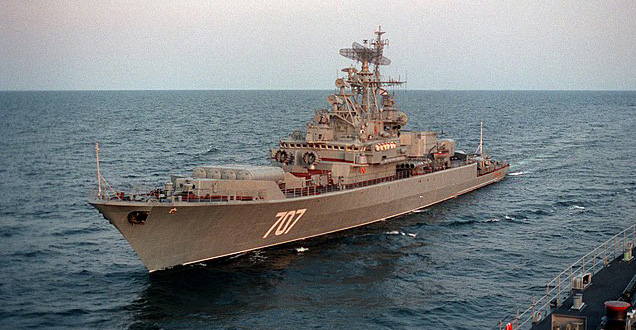
“Watchful” was laid down at Yantar, Kaliningrad on 21 July 1968, launched 28 March 1970 and completed in 31 December 1970, she served with the Baltic, Decommissioned in 1996.
She was accepted into the Baltic Fleet 20.2.71 (with the 128th Brigade) and from June 1971 to October she was in qualifications and weapons tests, mainly in the Black Sea, fring the URPK-4 (SS-N-14) and Osa-M (SA-N-4). By 4 August 1971 she was visited by General Secretary L.Brezhnev and Navy Commander Gorshkov in Feodosiya. She stopped at Gdynia in Poland from 5.10 to 9.10.71 on her return trip. From 14 june to 29 november 1972 she operated in the Mediterranean with Task Force KUG-1 together with the cruiser “Oktyabrskaya Revolutsiya” and the frigates “Speshnyy”, “Slavnyy” “Bodryy” in ASW training, and supporting Egypt and Syria during their war with Israel. She visited Dubrovnik on her way back, in Yugoslavia and from 5-9 October 1973 visited Gdynia in Poland with “Silnyy” and escorting the cruiser Sverdlov, flagship of the Baltic Fleet. On 28 March to 18 april 1974 she operated in the North Sea and stopped again on 20-24 july in Gdynia. In October 1974 she was again in operations, the North Sea.
On 14-24 March 1977 she took part in the major Sever-77 Atlantic fleet exercise. From August 1977 to February 1978 she made a Mediterranean TOD, also pushing to the Atlantic and Carribean, visiting Cuba twice and tracking along the way NATO submarines and warship. Later she took part in “Baltika-78” exercise. In September 1978 she visited Copenhagen and by 2-6 October was back tracking NATO Baltic exercises. In January 1979 she visited Rostock in East Germany and on 3-10 October, Warnemünde. She made another major deployment between the Atlantic and Mediterranean, from 18 March to 27 June 1980 and too, part in Atlantika-80 exercise (27-30 June 1980 with the frigates Druzhnyy directly under Commander Gorshkov.
She visited Annaba in Algeria in June, and on her way back, Stettin in Poland in July, escorting in September-October the Hybrid Carrier Kiev with Slavnyy from the Baltic Straits to the Norwegian Sea. She crossed the Atlantic and by April-May 1981 she visited Havana and Cienfuegos with “Nikolayev”, “Svirepyy” and followed by the tanker Olekma for the “Khiron-20” exercise with the Cuban Navy. In May-July she was back in the Mediterranean, escorting the SSN K-503 through the Gibraltar strait for a visit to Annaba. In July-August 1983 she escorted Kiev from the Mediterranean to the Baltic.
From February 1984 to January 1986 she had a major overhaul and modernization at Yantar, Kaliningrad. She received the new URK-5 (SS-N-14B) missiles notably, had a new networks, overhauled electronics, machinery, etc. On 24 April 1986 she separted for a major exercizes of the of combined Warsaw Pact fleet under Commander N.I. Khovrin and in June 1987 took part in OBESK-87. From July 1987 to April 1988 she visited Stettin and by August-September 1988 she took part in Baltic tactical exercise, in December she escorted the cruiser Kalinin for her transit to the Northern Fleet. In May-June 1989 she took part to the OBESK-89 exercise and in October visited Rostock. In January-July 1990 she made a ong cruise to the Central and southern Atlantic and later was based at Luanda, Angola for a time, then when back she stopped at Antwerp in Belgium for the first time, in June 1991, as well as Amsterdam. In November-December she returned in the Mediterranean, scorting the Admiral Kuznetsov from Gibraltar to 64 degrees North. In June 1993 she took part in joint NATO exercise “Baltops-93” but soon after her crew was reduced, she as placed in reserve, and she was decommissioned on 31 July 1996, disarmed in December, sold for BU in late 1997, to a Virgin Islands company.
 Bodryy
Bodryy
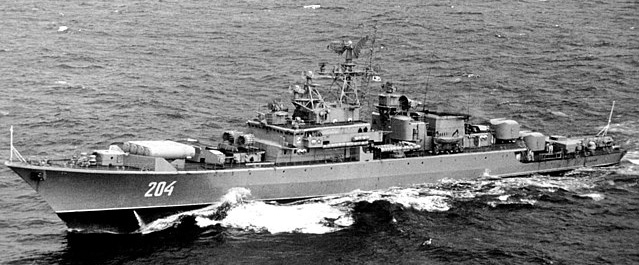
“Brisk” was from Yantar, Kaliningrad, laid down 15 January 1969, launched 28 April 1971, completed 31 December 1971, service in the Baltic, Decommissioned in 1997.
 Dostoynyy
Dostoynyy

“Virtuous” was laid down at Zaliv, Kerch on 11 August 1969, launched 8 May 1971, completed on 31 December 1971 and assigned to the Northern fleet, Decommissioned in 1993.
 Svirepyy
Svirepyy
“Fierce” was laid down at Yantar, Kaliningrad on 15 June 1970, she was launched on 27 January 1971 and completed on 29 December 1972, assigned to the Baltic, Decommissioned in 1993.
 Silnyy
Silnyy
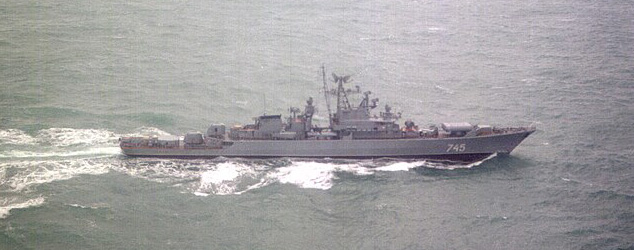
“Strong” was from Yantar, laid down on 15 March 1971, launched on 29 August 1972 and completed on 30 June 1973, assigned to the Baltic, Decommissioned in 1994.
 Doblestnyy
Doblestnyy
“Valorous” was laid down in Zaliv, Kerch on 30 November 1970, launched on 22 February 1973 and completed on 28 December 1973, assigned to the Northern fleet and Decommissioned in 1992
 Storozhevoy
Storozhevoy
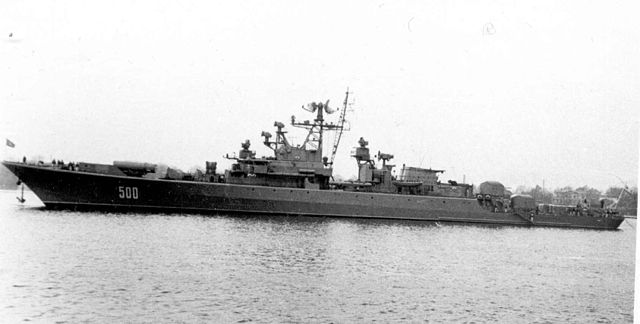
“Vigilant” was from Yantar, laid down on 20 July 1972, launched on 21 March 1973, commissioned on 30 December 1973 ans assigned to the Pacific Fleet. Before being decommissioned in 2002 she experienced a famous mutiny in 1975, which inspired the novel The “Hunt for Red October”. Built in Yantar, Kaliningrad she was accepted into the Baltic Fleet on 7 December 1974 with the 128th Brigade. In October she visited Rostock and for five months in January-May 1975 she operated in the Central Atlantic and Caribbean with Svirepyy. The famous mutiny took place on 8 November 1975 led by the deputy political commander, with the intent of sailing to Sweden (officially). The mutiny was ended by air attacks. Back to port, the entire crew was disbanded, replaced by the crew of Druzhnyy. In Januar-March 1976 she operated from Baltiysk and sailed around Africa as well as to Petropavlovsk-Kamchatka.
She was transferred to the Pacific Fleet on 6 november 1976 to the 173rd Brigade. In 1977 she operated off the Kuriles and Sea of Okhotsk, together with Razumnyy? She had a major overhaul from October 1978 to February 1979 repairs at SRZ M49, Vilyuchinsk. She spent the whole year 1980 in the Indian Ocean, making several replenishments at sea and visiting Massawa in Ethiopia in September. She sailed with Ivan Rogov. On 24 August 1983 she was ordered by Fleet Admiral Gorshkov to rescue the crew of the K-429 which sank near Sarannaya. In Octber 1983 she took part in exercises with Razumnyy under stormy weather, “Dlinnaya Osen” in the Sea of Okhotsk, a large ASW manoeuver with Novorossiysk, Nikolayev, Vasiliy Chapaev and the submarines “K-242”, “B-299”, “B-404” and shore based aircraft. She had a last overhaul from March 1987 to November 1994 with modernization at Dalzavod in Vladivostok interrupted by the fall of USSR. She received the new URK-5 (SS-N-14B) missiles but lack of funding delayed advances until she was decommissioned on 13.10.2002, disarmedand in 2003 sold to China for scrap (officially).
 Razumnyy
Razumnyy
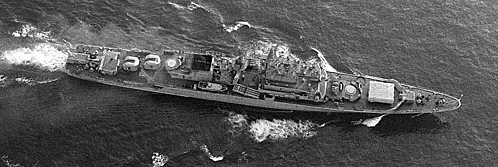
“Clever” was laid down at Yantar on 26 June 1972, launched on 20 July 1973, completed on 30 September 1974 and assigned to the Pacific Fleet, decommissioned in 1998.
 Razyashchiy
Razyashchiy
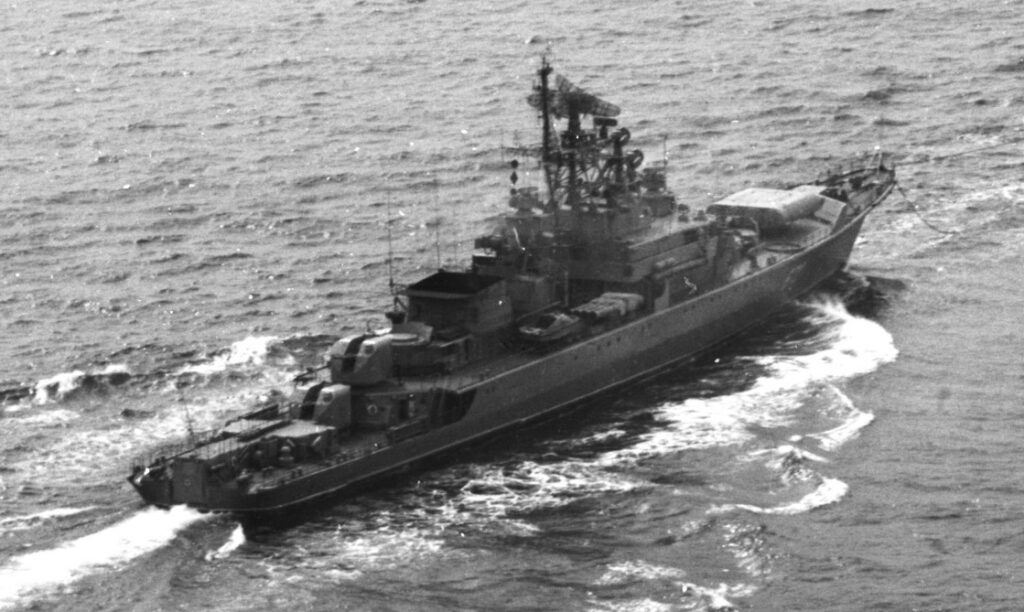
“Striking” was from Yantar, laid down on 28 September 1972, launched on 22 July 1974, completed on 30 December 1974 and assigned to the Pacific, then Decommissioned in 1992.
 Druzhnyy
Druzhnyy
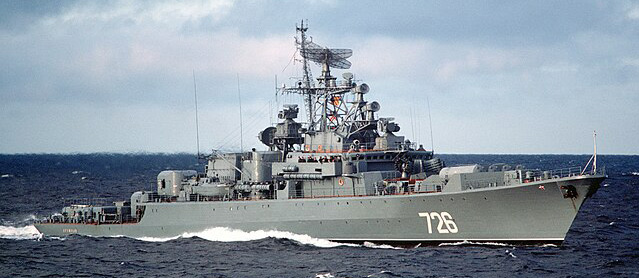
“Friendly” was from Yantar, laid down on 12 October 1973, launched on 22 January 1975 and commissioned on 30 September 1975. She was assigned to the Baltic and Decommissioned in 2002. She was preserved as floating museum, now anchored on the Moscow River (northwest district).
 Deyatelnyy
Deyatelnyy
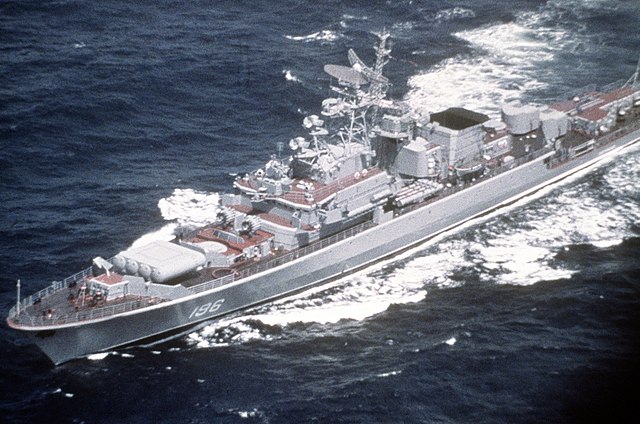
“Active” was built at Zaliv, Kerch, laid down on 21 June 1972, launched 5 April 1975 and commissioned on 25 December 1975, assigned to the Black Sea, Decommissioned in 1995
 Retivy
Retivy

“Ardent” was from Zhdanov in Leningrad, she was laid down on 12 June 1974, launched on 14 August 1976 and completed on 28 December 1976, assigned to tbe Pacific Fleet and Decommissioned in 1995.
 Bezzavetnyy
Bezzavetnyy
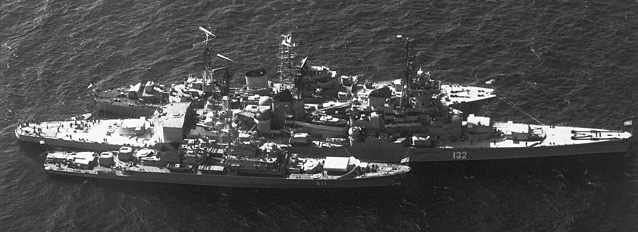
“Serene” was built at Zaliv, laid down on 28 May 1976, launched on 7 May 1977 and completed on 30 December 1977, assigned to the Black Sea. She Collided with USS Yorktown in February 1988, in what was called the “Black Sea bumping incident” after an agressive manoeuver. She was transferred to the Ukrainian Navy on 1 August 1997, Decommissioned in 2000.
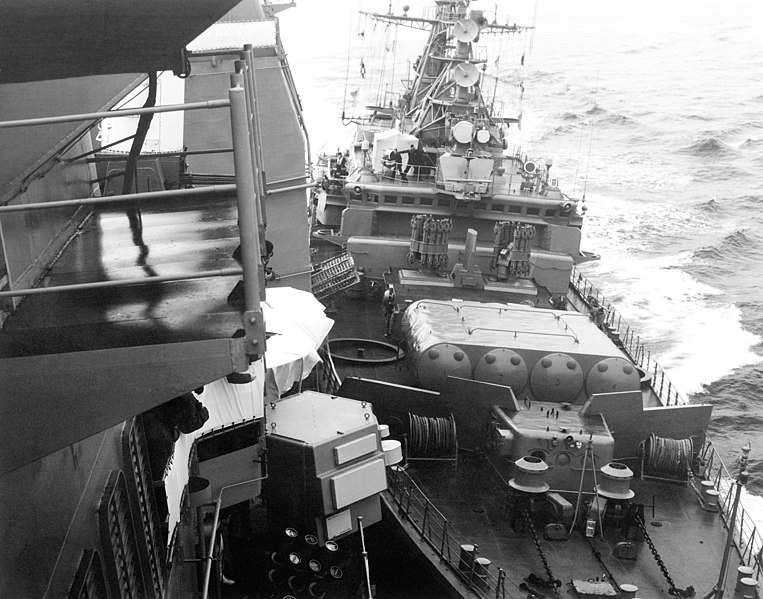
 Zadornyy
Zadornyy
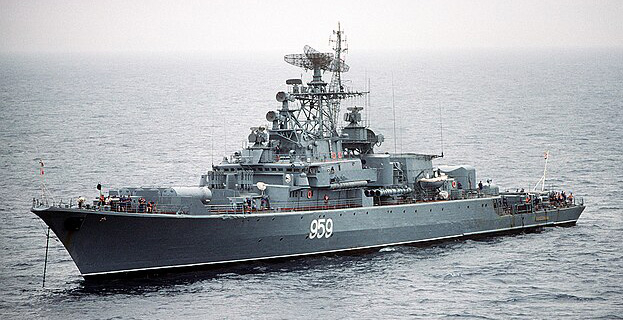
“Passionate” was built at Zhdanov, Leningrad, laid down on 10 November 1977, launched on 25 March 1979, commissioned on 31 August 1979 and assigned to the Northern Fleet, then Decommissioned in 2005.
 Bezukoriznennyy
Bezukoriznennyy

“Irreproachable” was from Zaliv, laid down on 12 July 1978, launched on 3 June 1979 and commissioned on 29 December 1979, assigned to Black Sea. Transferred to Ukrainian Navy on 1 August 1997, she was Decommissioned in 2000.
 Ladnyy
Ladnyy
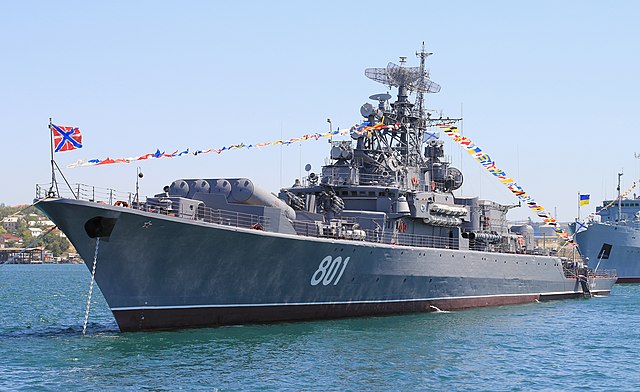
“Harmonious” was from Zaliv in Kerch, laid down on 25 May 1979, launched on 7 May 1980 and completed on 29 December 1980, assigned to the Black Sea. She had a complete refit in 2021, returned to the fleet and is thus active today.
 Poryvistyy
Poryvistyy

“Impetuous” was laid down in Zaliv on 21 May 1980, launched on 16 May 1981 and commissioned on 29 December 1981, then assigned to the Pacific Fleet. She was Decommissioned in 1994 and transferred to Vladivostok on 25 November 1994 as training ship, berthed. Status:
Project 1135M (Krivak II)
 Rezvyy
Rezvyy
“Frisky” was laid down at Yantar on 12 December 1973, launched on 30 May 1975, launched 30 December 1975, Northern fleet, Decommissioned in 2001
 Rezkiy
Rezkiy
“Sharp” was from Yantar, laid down on 28 July 1974, launched 17 February 1976 commissioned on 30 September 1976. She was assigned to the Pacific and Decommissioned in 1995.
 Razitelnyy
Razitelnyy

“Striking” was from Yantar, laid down on 11 February 1975, launched on 1 July 1976, commissioned on 31 December 1976, assigned to the Black Sea, Transferred to Ukrainian Navy on 1 August 1997 and Decommissioned in 2004.
 Grozyashchiy
Grozyashchiy
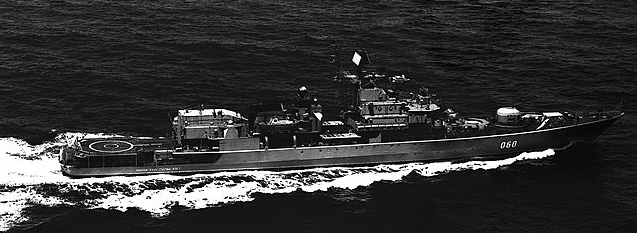
“Threatening” was from Yantar, laid down on 4 May 1975, launched on 7 February 1977 and completed on 30 September 1977, assigned to the Pacific Fleet. She was Decommissioned in 1995
 Neukrotimyy
Neukrotimyy
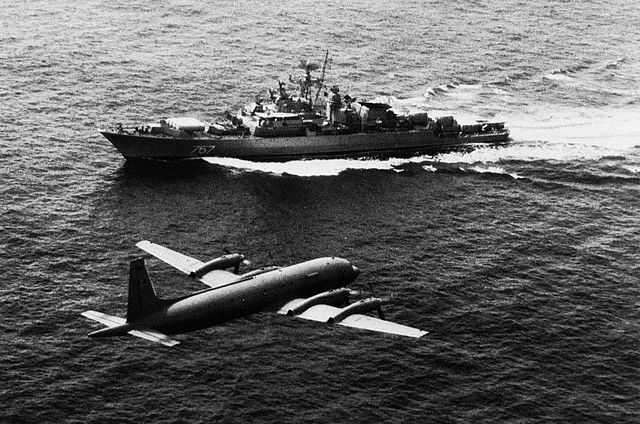
“Indomitable” was from Yantar, laid down 22 January 1976, launched 7 September 1977, commissioned on 30 December 1977, Baltic Fleet. Decommissioned in 2009 she sank on 5 November 2012.
 Gromkiy
Gromkiy
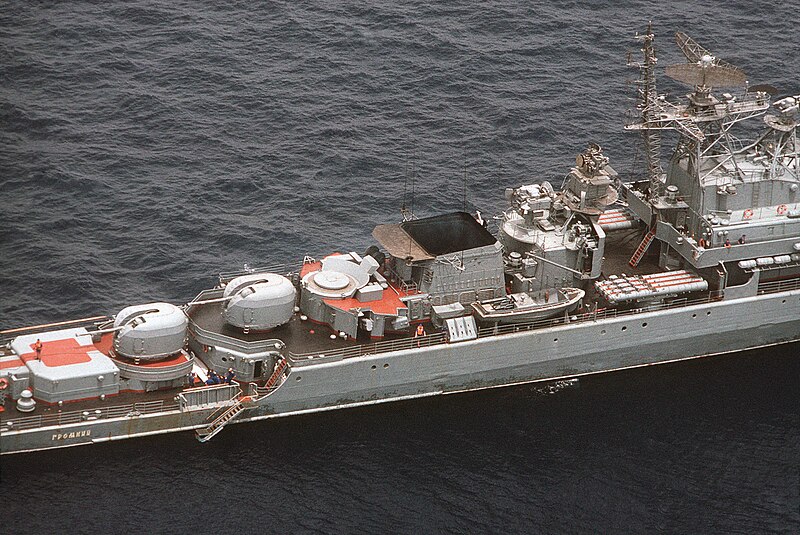
“Loud” was from Yantar, laid down on 23 June 1976, launched 11 April 1978 and commissioned on 30 September 1978. She was assigned to the Northern fleet and Decommissioned in 1998.
 Bessmennyy
Bessmennyy
“Unchanging” was built at Yantar, laid down on 11 January 1977, launched on 9 August 1978 and completed on 26 December 1978, assigned to the Northern fleet and Decommissioned in 1998.
 Gordelivy
Gordelivy
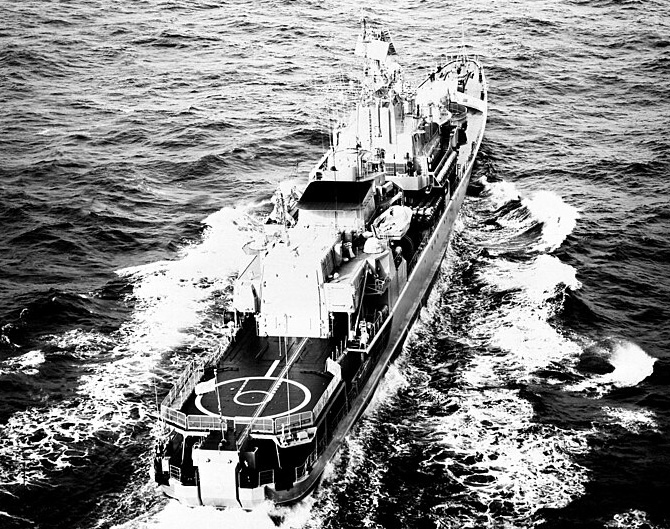
“Proud” was from Yantar, laid down on 26 July 1977, launched on 3 May 1979 and commissioned on 20 September 1979, assigned to the Pacific Fleet, Decommissioned in 1994.
 Ryavnyy
Ryavnyy
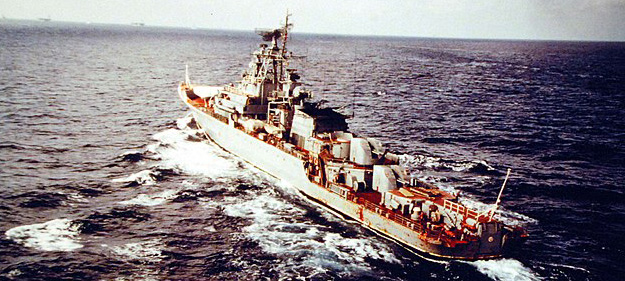
“Spirited” was built at Yantar, laid down on 1 March 1978, launched on 1 September 1979 and commissioned on 31 December 1979, Pacific Fleet. She was decommissioned in 1997.
 Revnostnyy
Revnostnyy
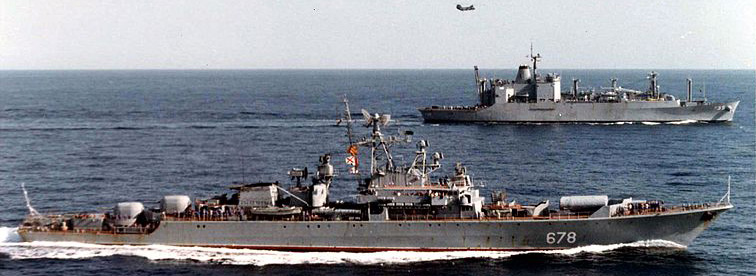
“Zealous” was from Yantar, laid down on 1 March 1978, launched on 1 September 1979, commissioned on 31 December 1979, assigned to the Pacific Fleet and decommissioned in 2003
 Pytlivyy
Pytlivyy

“Keen” is from Yantar, laid down on 27 June 1979, launched on 16 April 1981, completed on 30 November 1981, assigned to the Black Sea Fleet, Active today after refit.
Project 11351 Nerey (Krivak III) – KGB Patrol
 Menzhinskiy
Menzhinskiy
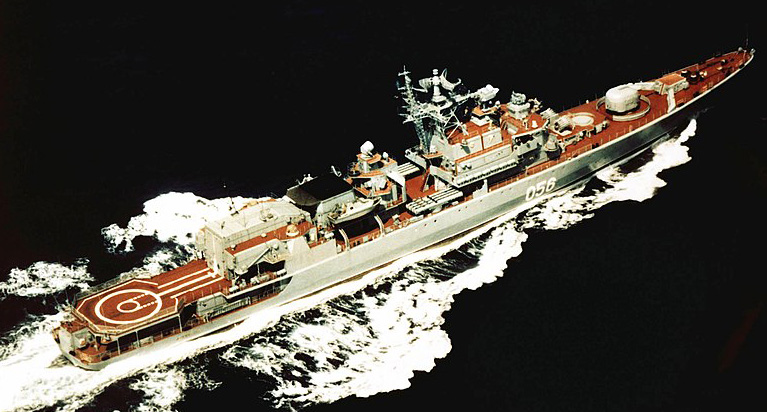
Named after Vyacheslav Menzhinsky, she was built at Zaliv, Kerch, started 14 August 1981, launched 31 December 1982, completed on 29 December 1983, assigned to the Pacific Fleet and Decommissioned in 1998.
 Dzerzhinskiy
Dzerzhinskiy
Named after Felix Edmundovich Dzerzhinsky, she was from Zaliv, laid down on 20 January 1983, launched 2 March 1984, completed on 29 December 1984, assigned to the Pacific Fleet and Active still with the Russian Coast Guard.
 Oryol
Oryol
She was the ex-Imeni XXVII, siezda KPSS, Yuri Andropov) built at Zaliv, laid down 26 September 1983, launched 2 November 1985, commissioned on 30 September 1986, assigned to the Pacific fleet, and now in reserve, Russian Coast Guard.
 Pskov
Pskov
(ex-Imeni 70-letiya VChK-KGB) she was from Zaliv, laid down 26 December 1985, launched 18 February 1987, commissioned 29 December 1987, assigned to the Pacific, Decommissioned in 2002
 Anadyr
Anadyr
(ex-Imeni 70-letiya Pogranvoysk) also from Zaliv, laid down 2 April 1987, launched 2 March 1988, completed 30 December 1988, assigned to the Pacific Fleet, Decommissioned in 2002
 Kedrov
Kedrov
Named after “Mikhail Sergeevich Kedrov” she was from Zaliv, laid down on 4 April 1988, launched 30 April 1989, commissioned on 28 December 1989, assigned to the Pacific, Decommissioned in 2002.
 Vorovskiy
Vorovskiy
Named after Vatslav Vorovsky, from Zaliv, started 15 May 1989, launched 28 July 1990, completed 29 December 1990, assigned to the Pacific, Decommissioned in 2017
 Hetman Sahaidachny
Hetman Sahaidachny
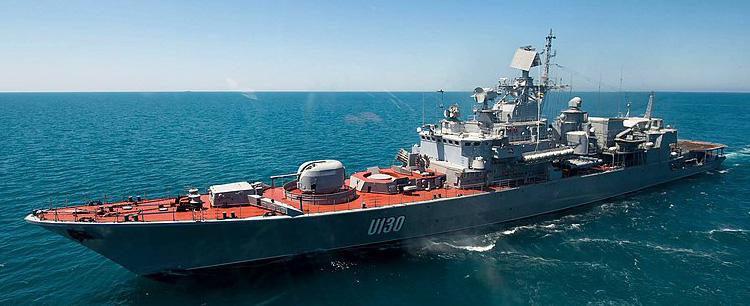
(ex-Kirov), after Ukrainian Hetman (lord) Petro Konashevych-Sahaidachny, also from Zaliv, laid down 5 October 1990, launched 29 March 1992, commissioned 2 April 1993, Scuttled March 2022 to avoid capture by the Ukrainians.

 Hetman Vyshnevetskyi
Hetman Vyshnevetskyi
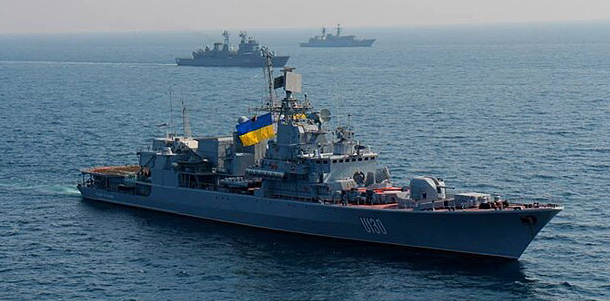
(ex-Krasny Vympel) after Dmytro “Baida” Vyshnevetsky, from Zaliv, laid down 27 December 1992 but Scrapped incomplete in 1995.
 Head no. 210
Head no. 210
Planned at Zaliv but Construction cancelled, never laid down, cancelled and scrapped incomplete in 1995.
Project 11352/11353 (Krivak IV)
 Lyogky
Lyogky
(ex-Leningradskiy Komsomolets) was from Zhdanov, Leningrad, laid down on 22 April 1974, launched 1 April 1977 and completed on 29 September 1977, assigned to the Northern fleet and decommissioned in 2003.
 Letuchiy
Letuchiy
“Flighty” was from Zhdanov, laid down on 9 March 1977, launched on 19 March 1978, commissioned on 10 August 1978, assigned to the Pacific Fleet and Decommissioned in 2005
 Pylkiy
Pylkiy
“Fervent” was from Zhdanov, laid down on 6 May 1977, launched on 20 August 1978 and commissioned on 28 December 1978, assigned to the Baltic and decommissioned in 2012
 Zharkiy
Zharkiy
“Heated” was from Zhdanov, laid down on 16 April 1974, lauched on 3 November 1975, commissioned on 29 June 1976 assigned to the Northern fleet and Decommissioned in 2002
Project 11356 (Talwar)
 Talwar
Talwar
“Sword” was ordered to the Baltic Shipyard, Saint Petersburg, on 10 March 1999, launched 12 May 2000, completed on March 2002 and transferred for commission on 18 June 2003 in India, active.
 Trishul
Trishul
“Trident” is from the Baltic Shipyard, laid down 24 September 1999, launched 24 October 2000 and commissioned on February 2002 in Russia, transferred on 25 June 2003 to India, also Active
 Tabar
Tabar
Tabar “Battle axe” is from Baltic Shipyard, laid down 26 May 2000, launched 25 May 2001, comp. January 2004, transferred 19 April 2004 to India, Active
 Teg
Teg
Teg “Saber” was from Yantar, laid down 28 July 2007, launched 27 October 2009, completed and commissioned ion India on 27 April 2012, Active
 Tarkash
Tarkash
“Quiver” was laid down in Yantar on 27 October 2007, launched 23 June 2010 completed October 2012 in Russia and transferred 9 November 2012 to India, Active
(Mythological arrow with three arrowheads) also from Yantar, laid down 12 June 2008, launched 25 May 2011, completed April 2013, transferred 29 June 2013 to India and Active
Project 11356P/M Krivak V (Admiral Grigorovich class)
 Admiral Grigorovich
Admiral Grigorovich
Named after Ivan Konstantinovich Grigorovich, from Yantar in Kaliningrad, laid down on 18 December 2010 launched on 14 March 2014, completed on 11 March 2016 from the Black Sea and Active
 Admiral Essen
Admiral Essen
Named after admiral Nikolai Ottovich Essen, also from Yantar, started 8 July 2011, launched 7 November 2014, completed 7 June 2016 for the Black Sea, Active
 Admiral Makarov
Admiral Makarov
Named after Admiral Stepan Osipovich Makarov, from Yantar, laid down 29 February 2012, launched 2 September 2015, completed 27 December 2017 for the Black Sea, Active
 Admiral Butakov
Admiral Butakov
Named after admiral Grigory Ivanovich Butakov, from Yantar, laid down 13 July 2013, launched 5 March 2016 and completion expected in 2024 but sold to India under construction
 Admiral Istomi
Admiral Istomi
Named after Vladimir Ivanovich Istomin, built at Yantar, started 15 November 2013, launched 16 November 2017 completion expected 2024, probably for India.
 Admiral Kornilov
Admiral Kornilov
Named after admiral Vladimir Alexeyevich Kornilov, from Yantar, laid down 16 November 2017, suspended, launched and completon expected by 2026, status “sold abroad”, probably India.

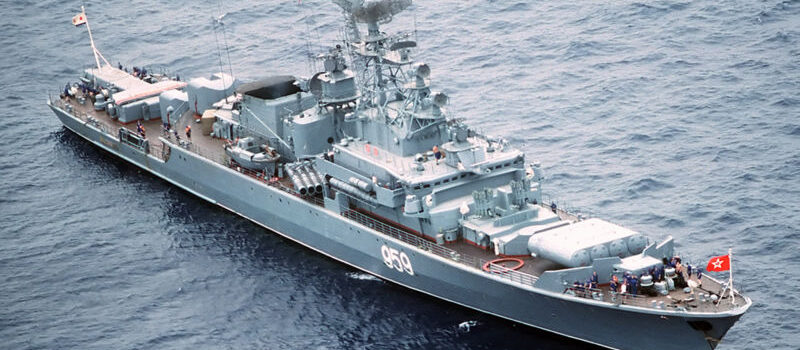

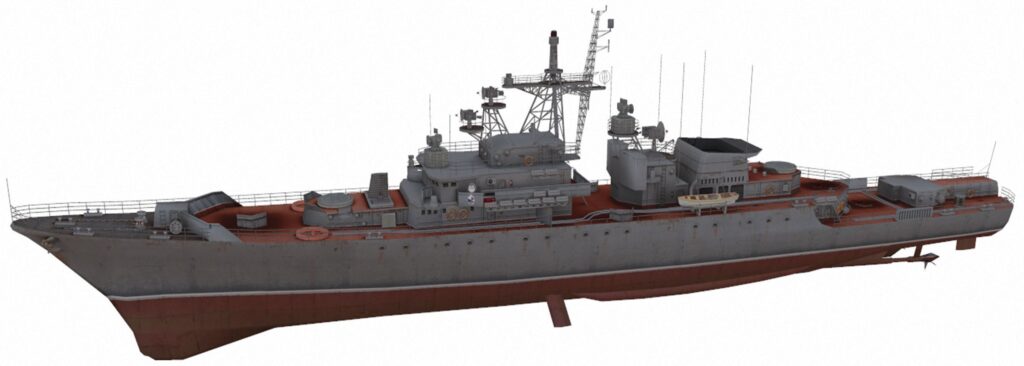
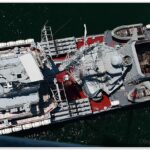
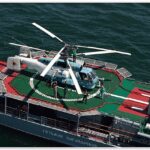
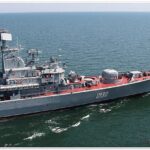
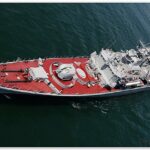
 Latest Facebook Entry -
Latest Facebook Entry -  X(Tweeter) Naval Encyclopedia's deck archive
X(Tweeter) Naval Encyclopedia's deck archive Instagram (@navalencyc)
Instagram (@navalencyc)





 Austrian Navy
Austrian Navy French Navy
French Navy Royal Navy
Royal Navy Armada Espanola
Armada Espanola K.u.K. Kriegsmarine
K.u.K. Kriegsmarine Dansk Marine
Dansk Marine Nautiko Hellenon
Nautiko Hellenon Koninklije Marine 1870
Koninklije Marine 1870 Marinha do Brasil
Marinha do Brasil Osmanlı Donanması
Osmanlı Donanması Marina Do Peru
Marina Do Peru Marinha do Portugal
Marinha do Portugal Regia Marina 1870
Regia Marina 1870 Nihhon Kaigun 1870
Nihhon Kaigun 1870 Preußische Marine 1870
Preußische Marine 1870 Russkiy Flot 1870
Russkiy Flot 1870 Svenska marinen
Svenska marinen Søværnet
Søværnet Union Navy
Union Navy Confederate Navy
Confederate Navy Armada de Argentina
Armada de Argentina Imperial Chinese Navy
Imperial Chinese Navy Marinha do Portugal
Marinha do Portugal Mexico
Mexico Kaiserliche Marine
Kaiserliche Marine 1898 US Navy
1898 US Navy Russkiy Flot
Russkiy Flot French Naval Aviation
French Naval Aviation Russian Naval Aviation
Russian Naval Aviation Sovietskiy Flot
Sovietskiy Flot Royal Canadian Navy
Royal Canadian Navy Royal Australian Navy
Royal Australian Navy RNZN Fleet
RNZN Fleet Chinese Navy 1937
Chinese Navy 1937 Kriegsmarine
Kriegsmarine Chilean Navy
Chilean Navy Danish Navy
Danish Navy Finnish Navy
Finnish Navy Hellenic Navy
Hellenic Navy Polish Navy
Polish Navy Romanian Navy
Romanian Navy Turkish Navy
Turkish Navy Royal Yugoslav Navy
Royal Yugoslav Navy Royal Thai Navy
Royal Thai Navy Minor Navies
Minor Navies Albania
Albania Austria
Austria Belgium
Belgium Columbia
Columbia Costa Rica
Costa Rica Cuba
Cuba Czechoslovakia
Czechoslovakia Dominican Republic
Dominican Republic Haiti
Haiti Hungary
Hungary Honduras
Honduras Estonia
Estonia Iceland
Iceland Eire
Eire Equador
Equador Iran
Iran Iraq
Iraq Latvia
Latvia Liberia
Liberia Lithuania
Lithuania Mandchukuo
Mandchukuo Morocco
Morocco Nicaragua
Nicaragua Persia
Persia San Salvador
San Salvador Sarawak
Sarawak Uruguay
Uruguay Venezuela
Venezuela Zanzibar
Zanzibar Warsaw Pact Navies
Warsaw Pact Navies Bulgaria
Bulgaria Hungary
Hungary

 Bundesmarine
Bundesmarine Dutch Navy
Dutch Navy Hellenic Navy
Hellenic Navy Marina Militare
Marina Militare Taiwanese Navy
Taiwanese Navy Chinese Navy
Chinese Navy Indian Navy
Indian Navy Indonesian Navy
Indonesian Navy JMSDF
JMSDF North Korean Navy
North Korean Navy Philippines Navy
Philippines Navy ROKN
ROKN IDF Navy
IDF Navy Royal New Zealand Navy
Royal New Zealand Navy Egyptian Navy
Egyptian Navy South African Navy
South African Navy

































 RN
RN
 Marine Nationale
Marine Nationale
 Soviet Navy
Soviet Navy
 dbodesign
dbodesign